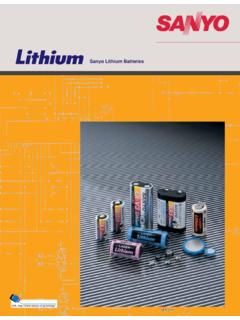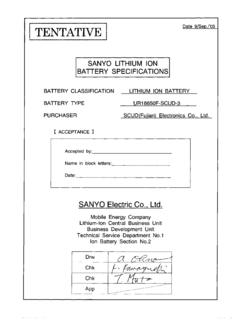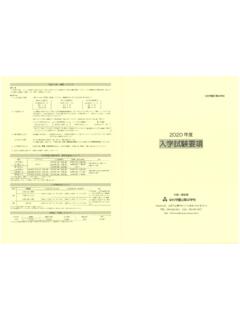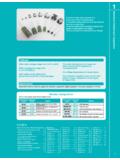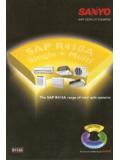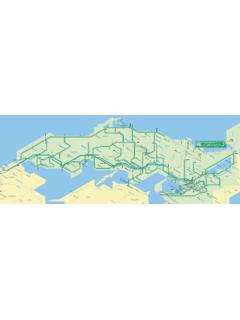Transcription of Sanyo Lithium Batteries - accu-profi
1 Sanyo Lithium Batteries URL SEB-025. Battery Handling Precautions for Your Own Safety . Lithium Batteries contain combustible materials such as Lithium metal and organic solvent. Improper handling can lead to heat generation, bursting or fire. To prevent accidents, follow these precautions and refer to them when precautions regarding Lithium battery usage are described in instruction manuals for equipment you are using. Coin-type Primary and Rechargeable Lithium Batteries WARNING! CAUTION! 1. Do not charge. 1. If leaked liquid gets in the eyes, wash (Primary Batteries , CR series). them with clean water and consult a When this battery is charged, gas is generated inside and raises physician immediately. internal pressure, resulting in fire, heat generation, leakage or 2. Do not use new and used Batteries bursting. together. Do not use different types of 2. Do not heat, disassemble nor dispose of Batteries together.
2 In fire. Doing so may cause heat generation, leakage or bursting. Doing so damages the insulation materials or the safety vent, 3. Do not apply strong pressure to the resulting in fire, heat generation, leakage or bursting. Batteries nor handle roughly. Doing so may cause heat generation, leakage or bursting. 3. Do not insert Batteries with the + and -- polarities reversed. 4. Do not use nor leave the Batteries in Make sure the polarities are in the right position when inserting the direct sunlight nor in high-temperature Batteries into equipment. When using 3 or more Batteries , the areas. equipment may operate even though one of the Batteries is Doing so may cause heat generation, leakage or bursting. improperly inserted. But this may cause leakage or bursting. 5. Avoid contact with water. 4. Do not short-circuit. Doing so may cause heat generation. If the + and --- come into contact with metal objects, short circuiting 6.
3 Make sure to insert Batteries without occurs resulting in heat generation or bursting. When carrying or having the + and -- come in contact storing Batteries , avoid direct contact with metal objects such as with metal parts of equipment. bracelets or key chains by putting them in a separate bag. 7. Read the equipment instruction manual 5. Keep Batteries out of children's reach. and precautions carefully before use. If leaked liquid is ingested or a battery is swallowed, consult a Some usages or types of equipment do physician immediately. not suit the specifications or performance of these Batteries . 6. In case of leakage or a strange smell, keep away from fire to prevent ignition of 8. Keep Batteries away from direct sunlight, any leaked electrolyte. high temperature and humidity. Leaving Batteries in such places may cause heat generation. 7. Do not solder directly. This can damage the insulation materials, resulting in fire, heat 9.
4 For proper disposal, follow local generation, leakage or bursting. government regulations. 8. Be sure to wrap each battery when disposing or storing to avoid short sircuit. Putting Batteries together or in contact with metal objects causes short circuiting, resulting in fire, heat generation or bursting. 9. Do not force-discharge. When a battery is force-discharged by an external power source, the voltage drops to 0 or less (reversal voltage) and gas is generated inside the battery. This may cause fire, heat generation, leakage or bursting. 10. Do not charge with high current and high voltage. (Rechargeable Batteries , ML, NBL series). Doing so may generate gas inside the battery, resulting in swelling, fire, heat generation or bursting. 1. Cylindrical-type Primary Lithium Batteries 10. Do not apply strong pressure nor handle roughly. WARNING! "DO NOT CHARGE" Doing so may cause fire, heat generation, leakage or bursting.
5 1. Do not use Batteries for unspecified 11. To prevent damage to the safety vent inside purposes. the battery, do not deform in any way. Differences in voltage or terminal configuration may cause an 12. Do not force-discharge. imperfect connection, fire, heat generation, leakage or bursting. When a battery is force-discharged by an external power source, the 2. Do not charge. voltage drops to 0 or less (reversal voltage) and gas is generated When this battery is charged, gas is generated inside and raises inside the battery. This may cause fire, heat generation, leakage or internal pressure, resulting in fire, heat generation, leakage or bursting. bursting. 3. Do not heat, disassemble nor dispose of 13. Do not damage nor peel off the resin film in fire. on the surface of the battery. Doing so damages the insulation materials or the safety vent, resulting in fire, heat generation, leakage or bursting.
6 CAUTION! 4. Do not insert Batteries with the + and -- 1. If leaked liquid gets in the eyes, wash polarities reversed. them with clean water and consult a Make sure the polarities are in the right position when inserting the physician immediately. Batteries into equipment. When using 3 or more Batteries , the equipment may operate even though one of the Batteries is 2. Do not use nor leave the Batteries in improperly inserted. But this may cause leakage or bursting. direct sunlight nor in high-temperature areas. 5. Do not short-circuit. Doing so may cause heat generation, leakage or bursting. If the + and --- come into contact with metal objects, short circuiting occurs resulting in heat generation or bursting. When carrying or 3. Avoid contact with water. storing Batteries , avoid direct contact with metal objects such as This can cause heat generation. bracelets or key chains by putting them in a separate bag.
7 4. Read the equipment instruction manual 6. Keep Batteries out of children's reach. and precautions carefully before use. If leaked liquid is ingested or a battery is swallowed, consult a Some usages or types of equipment do physician immediately. not suit the specifications or performance of these Batteries . 7. In case of leakage or a strange smell, keep away from fire to prevent ignition of 5. Keep Batteries away from direct sunlight, high temperature and humidity. any leaked electrolyte. Leaving Batteries in such places may cause heat generation. 8. Do not use new and used Batteries 6. Be sure to wrap each battery when together. Do not use different types of disposing or storing to avoid short sircuit. Batteries together. Putting Batteries together or in contact with metal objects causes Doing so may cause fire, heat generation, leakage or bursting. short circuiting, resulting in fire, heat generation or bursting.
8 9. Do not solder directly. 7. For disposal, follow local government Doing so may cause damage to insulation materials. It may also regulations. cause fire, heat generation, leakage or bursting. Precautions for Designing Equipment . For further information, refer to the Connection Terminal Specifications for Lithium Batteries and Key Circuit Design Points which is available upon request. 2. Featuring compact dimensions, high energy capacity and long-term durability, Lithium Batteries successfully meet today's needs. Connection Terminal Specifications . Sanyo meets various user requirements by developing an extended line of Batteries with different terminal designs (tabs, connectors and other terminals) as well as various battery holders. Regarding standard specifications and key circuit design points, see the separately provided "Connection Terminal Specifications for Lithium Batteries and Key Circuit Design Points.
9 ". International Transportation . Regulations for international transportation of Lithium Batteries may be largely classified into three categories. 1. Air transport Based on DGR (Dangerous Goods Regulations) of ICAO (International Civil Aviation Organization), IATA (International Air Transport Association) has determined transport regulations. The regulation states that Lithium Batteries are considered not dangerous if they meet the following requiremints: Each bare cell with a solid cathode must contain (Assembled battery using more than 2 cells must contain ) or less of Lithium or Lithium alloy. ( Sanyo 's Lithium Batteries are all solid cathodes.). They may be transported in rigid packaging with short-circuit protection. 2. Marine Transport IMO (International Marine Organization) has determined transport regulations based on IMDG (International Marine Dangerous Goods). The judgement standard of dangerous goods is based on DGR of ICAO.
10 When the Batteries are not regarded as dangerous goods, they should be transported in rigid packaging with short circuit protection, according to IATA standards. 3. DOT (Department of Transportation). Regulations for packaging and transportation of Lithium Batteries in the are determined by Code 49 CFR173. 185 of Federal Register. The judgement standard of dangerous goods corresponds to DGR of ICAO. When the Batteries are not regarded as dangerous, any transportation method is acceptable if they are transported in rigid packaging with short circuit protection. The following Sanyo Lithium Batteries contain less than of Lithium or Lithium alloy (under for assembled Batteries ) per single cell. CR1220, CR2016, CR2025, CR2032, CR2430, CR2450, CR-1/3N, 2CR-1/3N, CR15270, CR17335, CR14500, CR17335E-R, CR17335HE-R, CR17450E-R, CR17450HE-R, CR2, CR123A, CR-P2, 2CR5, CR-V3, CR14250SE, CR12600SE, CR17335SE, CR17450SE, CR14250SE-R, CR17335SE-R, CR17450SE-R.
